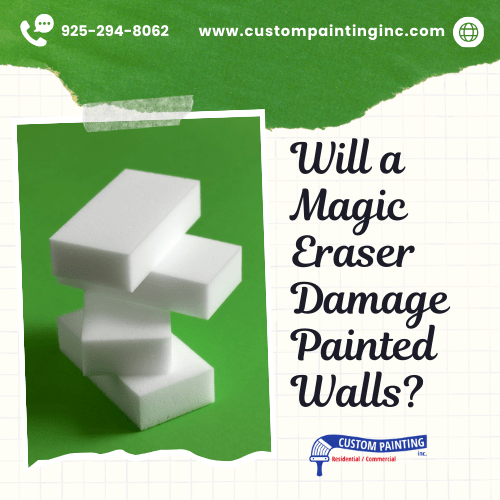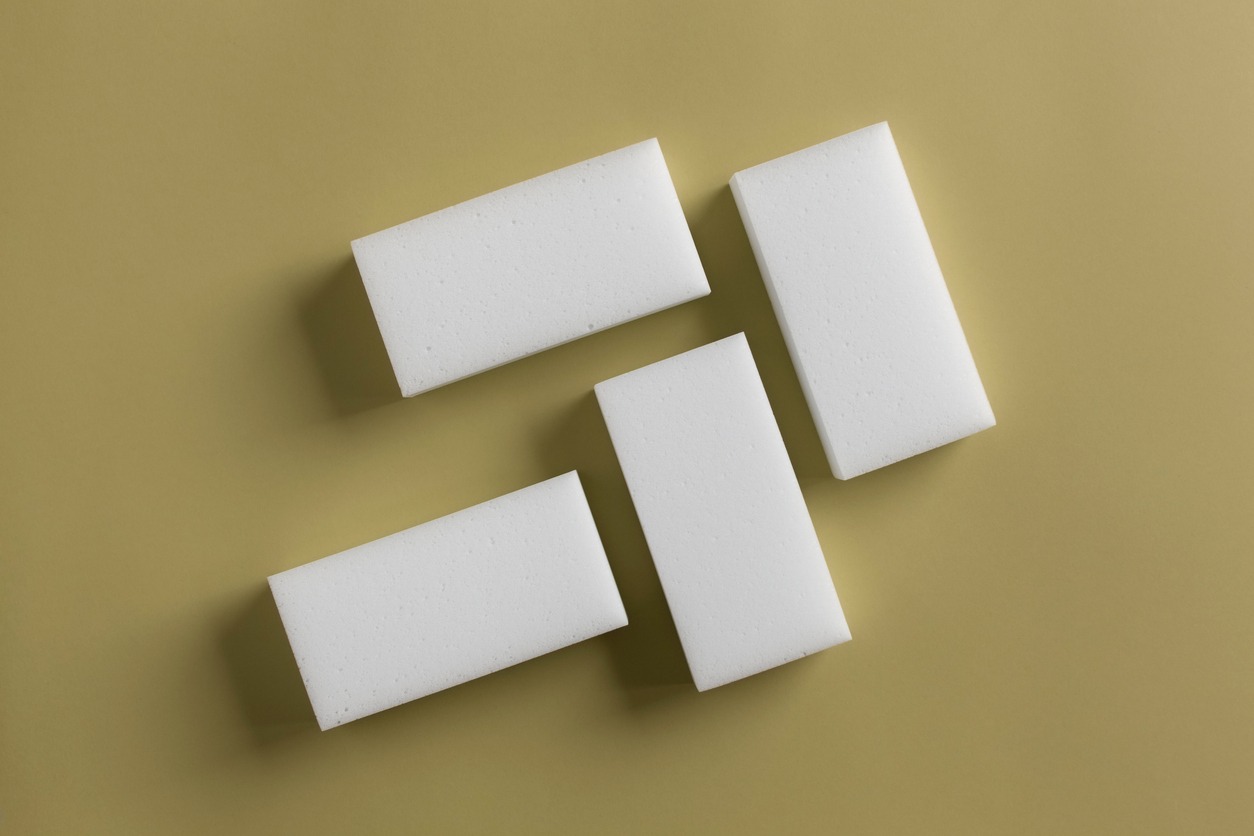If you’ve ever dealt with stubborn stains around your home, you’ve probably heard of Magic Erasers. They seem like a miracle cleaning tool, but if you’re like many people, you might wonder, “Will it damage my painted walls if I want to clean them with it?”
Let’s get to know if Magic Eraser is suitable for painted walls.
What is a Magic Eraser?
Magic Eraser, a Mr. Clean product, is made from melamine foam. This foam has a unique microstructure that makes it incredibly effective at cleaning. Adding water to the Magic Eraser makes it slightly abrasive, similar to very fine sandpaper. This abrasiveness allows it to scrub away tough stains and dirt without the need for harsh chemicals.
Since its launch in 2003, Mr. Clean Magic Erasers have become a household staple for many people due to their impressive ability to clean various surfaces with minimal effort. From scuff marks on floors to grime on kitchen appliances, these little white sponges seem to handle it all. But as handy as they are, knowing if they’re suitable for every cleaning job, especially for painted surfaces is essential.
Common Household Applications
Magic Erasers are known for their versatility. Here are a few common uses:
- Scuff marks on floors: They can quickly remove scuff marks from hardwood, laminate, and tile floors.
- Crayons and markers on walls: Parents often rely on Magic Erasers to clean up after their little artists.
- Kitchen appliances: They work wonders on greasy stovetops, microwave interiors, and even the exterior of your refrigerator.
- Bathroom surfaces: Soap scum and hard water stains on sinks, tubs, and shower doors don’t stand a chance against a Magic Eraser.
- Furniture: They can also clean up light stains on upholstery and remove marks from wooden furniture.
Effects of Magic Erasers on Painted Walls
Magic Erasers are undoubtedly versatile, but does this mean they’re safe for every surface?
While Magic Erasers are incredibly effective, they can pose some risks to painted walls. The main concern is abrasion. Since Magic Erasers work like fine sandpaper, there’s a chance they might scrub off more than just the stain, potentially removing some paint along with it. This can leave your walls looking patchy or discolored.
Not all walls are created equal, and several factors can influence how a Magic Eraser might affect your painted surfaces:
- Paint type: The paint on your walls plays a significant role. Flat and matte finishes are more susceptible to damage than glossy or semi-glossy paints, which are more durable and less likely to be affected.
- Wall texture: Smooth walls are generally safer to clean with a Magic Eraser than textured walls. The texture can catch and hold the abrasive material, increasing the risk of paint removal.
- Pressure applied: How hard you press can make a big difference. Applying too much pressure can increase the risk of scrubbing off the paint. It’s always best to start with light pressure and see how it goes.
When Should You Not Use a Magic Eraser for Walls?
Generally, when used with gentle pressure on flat and matte walls, Magic Eraser would not damage your walls. But there are instances when you should never use a Magic Eraser for cleaning walls, which includes the following:
Delicate or freshly painted walls
If your walls have just been painted or the paint is still curing, it’s best to avoid using a Magic Eraser. Fresh paint can be more vulnerable to damage, and you don’t want to ruin that fresh, pristine look. Give it a few weeks to fully cure before considering any kind of cleaning with a Magic Eraser.
Highly textured or decorative finishes
Magic Erasers are not suitable for walls with highly textured or decorative finishes. The eraser’s abrasive nature can wear down the texture or damage intricate designs. If you have walls with exceptional finishes, opt for gentler cleaning methods to preserve their look and feel.
Dark or deep-colored paints
Using a Magic Eraser on dark or deep-colored paints can be risky. The abrasive action might lighten the paint or create visible spots, making the wall look patchy. For darker walls, try a mild soap and water solution instead. It’s less likely to cause noticeable damage.
Glossy surfaces
While Magic Erasers are less likely to damage glossy surfaces than matte finishes, they can still dull the shine. If you have glossy or semi-gloss paint, it is better to use a soft cloth with a gentle cleaning solution to maintain the wall’s sheen.
Areas prone to frequent touches
High-traffic areas or spots prone to frequent touching, like around light switches and door handles, might show wear and tear more easily if cleaned with a Magic Eraser. These areas are already subject to more friction and contact, so using an abrasive cleaner can exacerbate the wear. Use a mild cleaner and a soft cloth for these spots to avoid additional damage.
Antique or specialty paints
If your walls have antique or specialty paints, steer clear of using Magic Erasers. These types of paint can be more delicate and prone to damage. Always check the manufacturer’s recommendations for cleaning these surfaces or consult a professional.
Precautions and Best Practices for Using Magic Eraser
To avoid any mishaps, here are some precautions and best practices to keep in mind when using a Magic Eraser on painted walls:
- Test a small, inconspicuous area first: Pick a spot behind a piece of furniture or near the baseboard. Gently rub the Magic Eraser on the area and check for any signs of paint removal or damage. If it looks good, you can proceed with more confidence.
- Use gentle pressure: Start with a light touch. You can always increase the pressure slightly if needed, but it’s better to err on the side of caution.
- Dampen the eraser: Wetting the Magic Eraser can make it less abrasive. Make sure to wring out any excess water so it’s damp, not dripping. A damp eraser will still clean effectively but is less likely to damage the paint.
- Wipe, don’t scrub: Instead of scrubbing back and forth, use gentle, circular motions. This technique helps to lift the stain without being too harsh on the paint.
Conclusion
Magic Erasers can be an excellent tool for many cleaning tasks around the house, but they’re not always the best choice for painted walls. Consider using a soft cloth with mild soap or a specialty cleaning product designed for painted surfaces to avoid potential damage.
If you have any concerns about cleaning your painted walls or need professional advice, don’t hesitate to contact Custom Painting, Inc. Our team of experts is here to help you with all your painting and maintenance needs. Call us today at 925-294-8062 for more information or use our contact form to schedule a consultation. Your walls deserve the best care, and we’re here to provide it!


